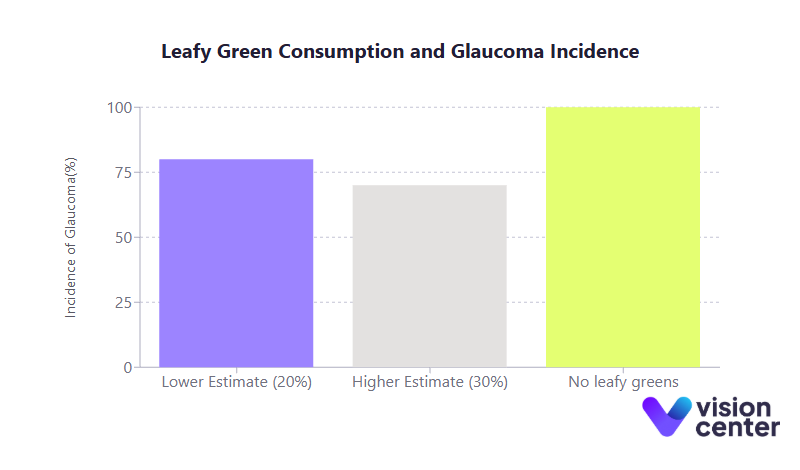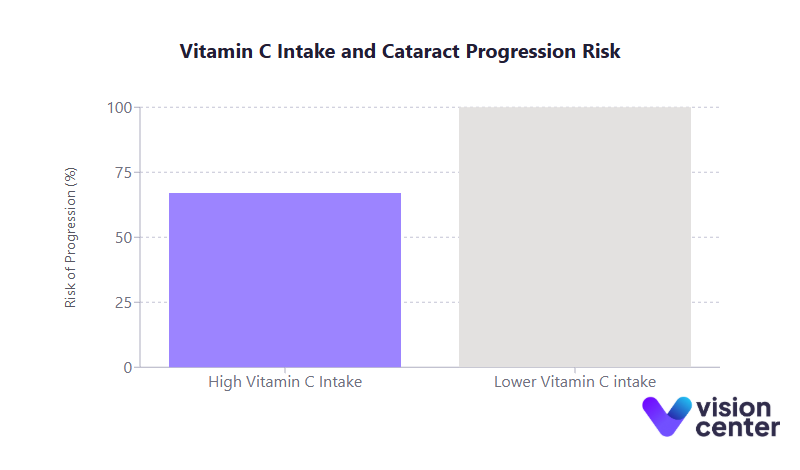Good vision is often taken for granted until problems arise. Research over the past decade has shown that the foods we eat and the supplements we choose have the potential to protect, preserve, and even optimize our eye health.
This article reviews statistical findings related to nutrition and vision, highlighting how specific nutrients, dietary patterns, and targeted supplements can lower the risk or slow the progression of major eye diseases.
While genetics, age, and other lifestyle factors certainly influence the health of our eyes, compelling evidence shows that diet and nutritional supplementation can be powerful allies. Epidemiological studies link higher intakes of vitamins and antioxidants to reduced cataract and macular degeneration risk, while clinical trials show that some supplements can slow the progression of age-related vision loss.
In what follows, we explore key data on nutrient-specific benefits, dietary patterns that safeguard vision, and the long-term economic and quality-of-life gains associated with nutrition-based eye care.
Noteworthy Statistics at a Glance
- 25% – Approximate lower risk of advancing to nuclear cataract among adults consuming the highest levels of lutein and zeaxanthin compared to those consuming the least.
- 10% – Estimated percentage of American adults who meet recommended fruit and vegetable intake, underscoring a population-wide gap in obtaining key eye-protective nutrients naturally.
- 25% – Reduction in the chance of progressing to advanced age-related macular degeneration (AMD) for intermediate-stage patients taking the AREDS2 high-dose vitamin/mineral supplement daily.
- 56% – Lower hazard of developing diabetic retinopathy in a large randomized trial among type 2 diabetes patients assigned to a Mediterranean-style diet (extra virgin olive oil) compared to a low-fat diet.

Nutrient-Specific Effects on Vision
Understanding which vitamins, antioxidants, and minerals play pivotal roles in eye health is essential. This data is important because it reveals how targeted intake of specific micronutrients can help delay or potentially prevent disease onset.
- Vitamin A (Retinol):
- Critical for forming rhodopsin, the pigment enabling low-light (night) vision.
- Deficiency can lead to night blindness and, in severe cases, permanent vision loss from damage to the cornea.
- Lutein & Zeaxanthin:
- Concentrated in the macula, where they filter harmful blue light and neutralize oxidative stress.
- High intake of lutein/zeaxanthin correlates with a notable drop (about 25%) in the risk of developing nuclear cataracts.
- Diets rich in these carotenoids may also lower the likelihood of progressing to advanced AMD.
- Omega-3 Fatty Acids (DHA/EPA):
- Structural components of retinal cells, with anti-inflammatory benefits that may help protect against diabetic retinopathy and early AMD.
- Clinical trials show mixed results for dry eye disease, with a large study finding no significant advantage for high-dose omega-3 supplements over placebo in moderate-to-severe dry eye.
- Zinc:
- Concentrated in the retina; essential for enzymes that protect photoreceptors.
- Included at high doses in the AREDS/AREDS2 formulas, where it helped reduce AMD progression risk.
- Also required alongside vitamin A for optimal night vision and immune function in the eye.
- Vitamins C & E (Antioxidants):
- Help neutralize free radicals in the lens and retina, potentially slowing cataract formation.
- A 10-year twin study found a 33% lower risk of cataract progression in those whose diets were high in vitamin C.
- These nutrients often appear in eye formulas aimed at reducing oxidative stress linked to AMD and other degenerative eye conditions.

Dietary Patterns and Preventive Impact
Scientific interest has shifted from isolated nutrients to overall dietary patterns, given the complexity of interactions among foods. The statistics below demonstrate the importance of looking beyond single vitamins toward an integrated, long-term approach to eating.
- Mediterranean Diet:
- Emphasizes vegetables, fruits, whole grains, fish, olive oil, and nuts, with limited intake of red meat and saturated fats.
- In older adults at risk for macular degeneration, a Mediterranean-style diet was associated with roughly a 25% lower risk of progressing from early to advanced AMD.
- A large-scale trial among those with type 2 diabetes showed that following a Mediterranean diet with extra virgin olive oil led to a significant reduction in the hazard of developing diabetic retinopathy compared to a low-fat diet.
- Leafy Greens & Nitrate-Rich Foods:
- Regular consumption of leafy greens (spinach, kale, lettuce) provides carotenoids and nitrates that convert to nitric oxide, potentially improving blood flow to the optic nerve.
- One long-term study of over 100,000 adults indicated a 20 to 30% lower incidence of primary open-angle glaucoma among the highest consumers of leafy greens.
- Low-Glycemic, High-Fiber Diets:
- Help maintain stable blood sugar levels, crucial for preventing diabetic eye complications.
- High intake of refined carbohydrates is linked to a greater risk of both AMD and diabetic retinopathy; thus, a balanced diet can mitigate retinal damage over time.
- “Western” High-Fat Diets:
- Characterized by frequent consumption of processed meats, saturated fats, and sugary foods.
- Repeatedly shown to correlate with higher rates of AMD, cataracts, and faster disease progression.
- Replacing unhealthy fats with healthier monounsaturated or polyunsaturated fats, such as those in olive oil and nuts, shows promise in lowering eye disease risk.
- Plant-Centric Approaches:
- Patterns that favor fruits, vegetables, whole grains, and legumes often show protective effects against age-related eye problems.
- In large observational cohorts, people with ample fruit and vegetable intake generally experience fewer cataract extractions and lower rates of AMD.
Effectiveness of Nutritional Supplements and Interventions
Clinical research over the last ten years has tested whether supplemental vitamins, minerals, and antioxidants can treat or slow degenerative eye diseases. These data points matter for people seeking evidence-based guidance on which supplements, if any, may help protect or enhance vision.
- AMD and AREDS Supplements:
- The Age-Related Eye Disease Study (AREDS) and its follow-up (AREDS2) demonstrated that a specific high-dose combination of vitamin C, vitamin E, zinc, copper, and carotenoids can lower the risk of progression from intermediate to advanced AMD by about 25%.
- The updated AREDS2 formula replaced beta-carotene with lutein and zeaxanthin, which may offer further benefit and avoids elevated lung cancer risk in smokers.
- These supplements do not cure AMD or prevent its initial onset; they primarily help those already diagnosed with moderate AMD to slow vision deterioration.
- Beyond AREDS for Other Eye Conditions:
- In the AREDS trials, high-dose antioxidant and mineral supplementation did not significantly prevent or reduce cataract progression.
- Omega-3 (EPA/DHA) was added to the AREDS2 supplement in a controlled study but showed no additional benefit for AMD or cataract prevention beyond the core formula.
- Research into other targeted nutrients (e.g., vitamin B3 for glaucoma) is ongoing, but no supplement has yet been proven to alter disease progression in glaucoma or diabetic retinopathy as definitively as AREDS2 has for AMD.
- Dietary Interventions for Diabetic Retinopathy:
- A major randomized trial among patients with type 2 diabetes found that switching to a Mediterranean diet resulted in fewer cases of sight-threatening diabetic retinopathy over several years.
- Merely adding a fish oil supplement or isolated nutrient to an otherwise poor diet typically does not produce meaningful prevention effects; overall diet quality remains paramount.
- Dry Eye Disease:
- Early studies hinted that omega-3 supplements help reduce dry eye symptoms, but a large, well-designed trial reported no significant difference between high-dose fish oil and placebo in moderate-to-severe cases.
- Nonetheless, for mild dry eye, improving dietary omega-3 intake from fish or seeds, along with better hydration, remains a practical approach that may offer modest relief.
- Age Group Differences:
- Children & Youth: Vitamin A and DHA are critical during retinal development, with some studies indicating improved infant visual acuity when mothers increase omega-3 intake during pregnancy.
- Adults (Middle Age): Balanced eating patterns established by mid-life can translate into lower rates of cataracts and macular issues in older adulthood.
- Seniors: Stand to gain the most from targeted supplements (like AREDS2) and modifications to diet to help slow ongoing vision deterioration.
Long-Term Benefits, Cost Factors, and Adherence
Nutritional support for the eyes is often a long-term investment in health. Statistical findings highlight sustained benefits across many years, potential savings in healthcare costs, and challenges in ensuring consistent patient compliance.
- Long-Term Eye Disease Prevention:
- Studies tracking subjects over a decade or more show that sustained high intake of antioxidant vitamins or adoption of a Mediterranean-style diet translates into lower rates of AMD, cataracts, and diabetic retinal damage.
- In extended follow-up research, those using AREDS2 vitamins still experienced reduced AMD progression several years after starting supplementation.
- Quality of Life Improvements:
- Preserving vision through nutritional measures can help older adults remain independent, continuing activities like reading and driving for more years.
- Even small delays in disease progression may significantly prolong functional vision, impacting daily tasks and social interactions.
- Economic Impact:
- Advanced eye conditions such as late-stage AMD or proliferative diabetic retinopathy can be extremely costly to manage, often involving expensive treatments or surgeries.
- Analyses show that AREDS2 supplementation is cost-effective for patients with intermediate AMD, saving thousands per patient by reducing the need for certain therapies.
- Improved diet and proactive supplement use can yield broad public health savings if widely adopted, especially among high-risk groups.
- Adherence Challenges:
- Fewer than 1 in 10 adults in the United States consistently meet recommended fruit and vegetable consumption guidelines, suggesting most miss out on key nutrients for eye health.
- Even among individuals diagnosed with AMD, only a portion follow daily supplementation advice, often due to lack of awareness or confusion regarding which formula to take.
- Cost of supplements and pill burden can discourage long-term use, but improved provider communication and more affordable supplement options can help close the compliance gap.
In the end, what we eat truly influences how we see the world, both literally and figuratively. While no diet or pill guarantees perfect eyesight for life, mounting statistics confirm that certain nutrients, dietary patterns, and carefully tested supplements can reduce the risk and slow the progression of the most common age-related eye conditions.
A growing body of research continues to refine our understanding of how specific diets and nutrients interact with ocular tissues. Such insights prove invaluable as populations age and seek low-cost, accessible methods of preserving visual function.
In many respects, this evidence-based approach to nutrition and vision goes beyond simply avoiding deficiencies. We now recognize that a robust, eye-focused dietary pattern can proactively strengthen critical eye structures, mitigate oxidative stress, and support vascular integrity.
When we translate these statistics into practical steps, we engage in a form of preventive health care that yields payoffs not just in immediate well-being but in freedom from visual disability later on. Ultimately, scientific data from the past decade reinforce a core principle: proactive, nutrition-centered strategies can significantly affect how well and how long we see.
In this article


